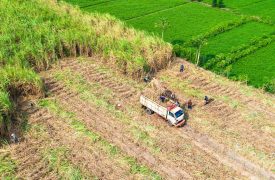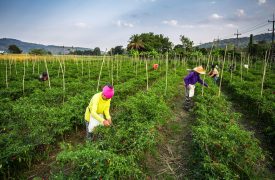See 2021 Food and Agriculture Benchmark
Governance and strategy | Leading practices from the 2021 Food and Agriculture Benchmark

What does good performance look like?
This is a question our food and agriculture team often receives from companies, allies and other stakeholders. Taking a holistic approach, companies in the benchmark are assessed across the measurement areas of governance and strategy, environment, nutrition and social inclusion. Companies are expected to set policies, strategies, targets or take specific action on each topic within these areas, all of which have specific (data) requirements. These requirements are based on societal expectations, existing and widely accepted reporting standards, best available science and guidance from experts, including research on existing initiatives and current practices. Translated into indicator scoring guidelines our methodology lays bare these requirements and why companies need to take action on each topic.
Food systems have major impacts on our health, society and the environment. Private sector action is crucially needed to address these challenges. The methodology for the Food and Agriculture Benchmark serves as a roadmap to guide companies through this transformation by identifying the areas of attention alongside clear expectations for companies. The 2021 Food and Agriculture Benchmark has shown that all companies are on a journey and stepping up efforts is needed even for the best performers. This publication aims to shine a light on leading practices on key topics that we have found in the benchmark. It provides a more practical understanding of what ‘good’ performance looks like, across topics as well as sectors and companies.
Below you find an overview of selected examples, chosen to illustrate leading practices across each measurement area and topic. These examples are intended to inspire and initiate conversations with companies on their performance. It is not an exhaustive list, but one that will be updated and supplemented moving forward. In addition, the benchmark’s data set provides a full overview of company scores against all 45 indicators, beyond the leading practice examples highlighted below.
Governance and strategy
This measurement area focuses on the integration of sustainable development objectives and targets into companies’ core strategy, business model and governance structure. It captures companies’ overall commitment to sustainable development, including climate change and environmental issues, food and nutrition security and social issues. It aims to assess the extent to which companies’ highest governing bodies can be held responsible and accountable for their progress on targets, as well as their stakeholder engagement activities and how outcomes are incorporated in their business strategy reviews.
Sustainable development strategy
Through a sustainable development strategy, companies can set priorities designed to meet the needs of stakeholders today, without compromising the ability to satisfy the needs of future generations. It allows companies to articulate their direction of travel, key priorities and make long-term and meaningful investments. Based on an agreed framework, it helps to set priorities for extending resources, creating an impact and communicating results. Such a strategy goes beyond corporate risk assessments and demonstrates that companies aim for positive impact through their activities, operations and through global value chains, on the environment and society.
Stakeholder engagement
Companies are part of society, at global and local levels, impacting the lives of their workers and consumers, the environment, global health as well as direct and indirect stakeholders of their operations and supply chains. Regularly engaging with stakeholders -such as local communities, governments, academia, business partners, investors and non-governmental organisations – contributes to a company’s understanding of diverse and frequently opposing perspectives, potentially drives innovation and helps to shape robust and inclusive approaches.
Conclusion and next steps
Leading practice examples are meant to inspire and instigate conversations with companies on their performance. With changing global contexts and (scientific) developments and progress around the understanding of many of the relevant topics in the benchmark, leading practices will change over time. The benchmark and its methodology will reflect this changing environment in which food and agriculture companies operate. Our methodology will evolve over time, as will the benchmark. We invite our allies, companies and other stakeholders to join the conversation or reach out to the food and agriculture team to keep abreast of our activities and next steps.


